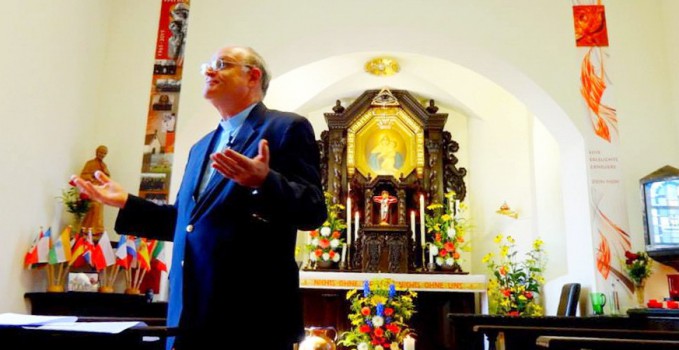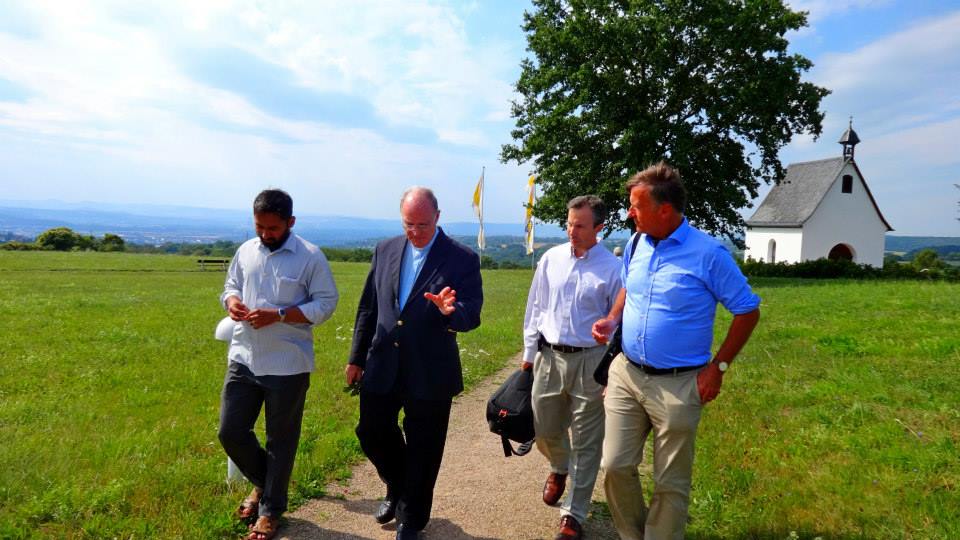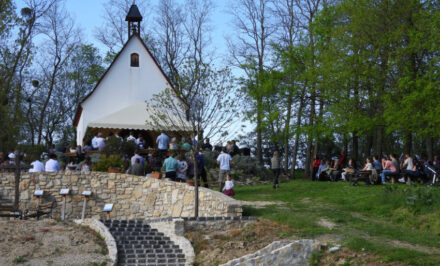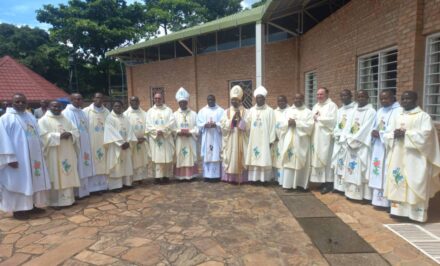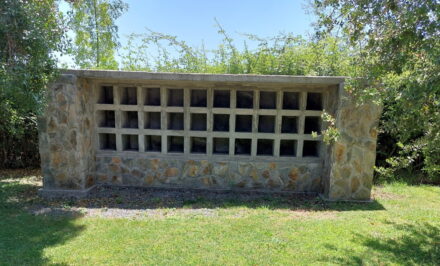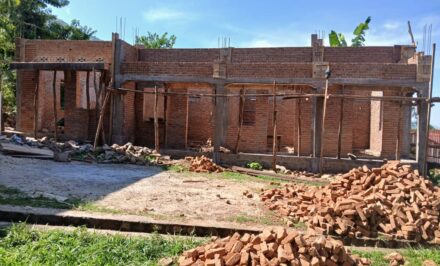Interview with ACIprensa, published 25 August, by Martha Calderón and Walter Sánchez Silva •
In the first interview granted after his election as General Superior of the Schoenstatt Fathers, Fr. Juan Pablo Catoggio, a 61 year-old Argentinean priest, speaks of the challenges for this spiritual family present in more than ninety countries that is marked by a profound love for Mary.
The Argentinean priest is the second Latin American to hold this position, and he succeeds Fr. Heinrich Walter, who led the Institute for twelve years.
In dialogue with ACIPrensa in Schoenstatt (Germany), he comments that his election was a surprise because he “did not expect it; he was not seeking it. Secondly [he was] somewhat frightened by the task, but also confident that God gives the strength and the necessary grace for the tasks that he also entrusts to us.”
On the centennial of this spiritual family celebrated in 2014, Fr. Catoggio affirms that this is a time of “renewal in the spirit of the Founder, in his charism, and in his mission. It was an international experience. The Movement had never gathered in such a multiform and colorful way with representatives from so many countries, so many cultures, and so many places” like India and some places in Africa. “After 100 years, Schoenstatt has a new face, a new geography.”
The General Superior recalls that “Schoenstatt was born with a happening, it was not a decision or a project from the desk of Father (Joseph) Kentenich, the Founder, but was the result of a life process, of an in-break of the Holy Spirit, of an event of grace that we call: “the Covenant of Love with the Blessed Mother.” Father (Joseph) Kentenich, the Founder, was a man who permanently sought the Will of God. For him, the Will of God was not a truth that had to be contemplated, but much more, a plan that had to be discovered and realized.”
For the Founder, continued the priest, “Love for the Blessed Mother was not to simply allow oneself to be doted on by the Blessed Mother, but for him, it always had the aspect or character of a mutual commitment. Therefore we say in Schoenstatt, and we call the consecration to Mary, the Covenant of Love. A Covenant, reciprocal, mutual. ‘Nothing without You, Nothing without us,’ we say many, many times in Schoenstatt.”
This, he continued, “…is an exchange where there is mutual commitment, that is love for love, commitment for commitment and where, therefore, that love for Mary is not simply sentimental and devotional, but that also has consequences in life.”
“It has pedagogical consequences; we could say it because it transforms our lives, we allow ourselves to be educated by Mary who always wants to shape Christ in us and wants the Gospel to be alive in us.”
The Schoenstatt Shrine
Father Kentenich and a small group of seminarians from the old seminary of the Pallottine Fathers founded Schoenstatt on October 18, 1914, as a way of spiritual renewal within the Catholic Church. The name of the Movement comes from a small village that is a part of the town of Vallendar, near Koblenz, Germany. The Original Schoenstatt Shrine is there and it has become a worldwide place of pilgrimage.
Fr. Catoggio explained, “The Shrine was not a strategy decision or a stroke of ‘marketing’ genius by Father Kentenich. In reality, it greatly helps to identify Schoenstatt in all places, but it is something more profound than that.”
“The Shrine is our mystery, if you can call it that, the Shrine is the source of graces because this is where Mary has established herself, from where she calls us and she nurtures our spirituality and our strength for the mission and apostolate.”
He continues, “Therefore the web of Shrines, which did not come forth from the beginning, emerged because life manifested itself in that way; it opened itself up and demonstrated new ways. In South America, in Uruguay to be exact, was where the initiative from the Schoenstatt Sisters of Mary to build an exact replica of the Original Shrine came forth.”
“When the Founder, who was in concentration camp, heard of this, he immediately supported it. He also discovered that it was not a strategy, but a strategy of God…that God truly wanted to extend this gift, this charism of Schoenstatt to the whole world just through the Shrines because without Shrines, Schoenstatt cannot be extended.”
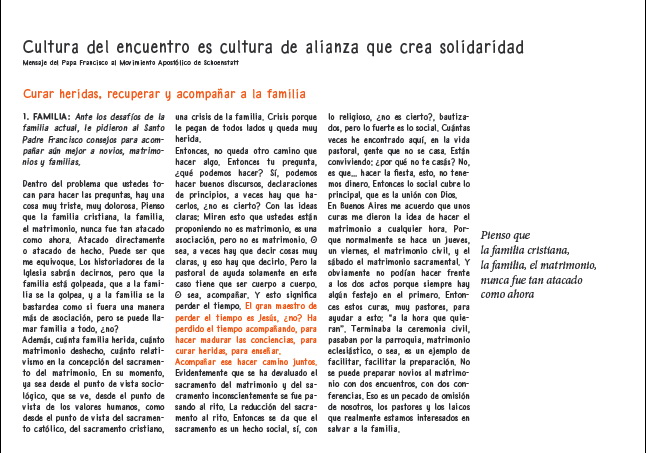 Fr. Cotaggio then said that “that Church for which Father Kentenich lived, died, worked, suffered, and dreamed is the Church that Pope Francis proposes to us, the one he carries in his heart, the one he is proclaiming everywhere and therefore believes that the encounter with him (on October 26th in the Paul VI Hall at the Vatican) was an encounter of commitment with him, with the Church, and was an encounter of sending forth.”
Fr. Cotaggio then said that “that Church for which Father Kentenich lived, died, worked, suffered, and dreamed is the Church that Pope Francis proposes to us, the one he carries in his heart, the one he is proclaiming everywhere and therefore believes that the encounter with him (on October 26th in the Paul VI Hall at the Vatican) was an encounter of commitment with him, with the Church, and was an encounter of sending forth.”
“I think that the greatest fruitfulness from these celebrations from the encounter with him, is that from our original places, from our charism, from our sources, we have to be reaching out.”
In conclusion, the new General Superior of the Schoenstatt Fathers said to ACIPrensa “using the words of the Pope, we have to go out to encounter everyone.”
Source: Aciprensa

All photos: Facebook Profile of the General Chapter of the Schoenstatt Fathers
Note: we corrected the error in the name of Fr. Juan Pablo Catoggio
Original Spanish: Translation: Carlos Cantú, Schoenstatt Family Federation, La Feria, Texas USA – Edited: Melissa Peña-Janknegt, Elgin, TX USA


